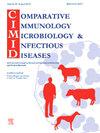Cutaneous leishmaniasis in Algeria: An expanding endemic disease
IF 2
3区 农林科学
Q4 IMMUNOLOGY
Comparative Immunology Microbiology and Infectious Diseases
Pub Date : 2025-06-06
DOI:10.1016/j.cimid.2025.102366
引用次数: 0
Abstract
Cutaneous leishmaniasis (CL), caused by Leishmania spp., is an important vector-borne and largely zoonotic disease in Algeria. The country ranks as the primary focus of leishmaniasis in the African subcontinent and the second-largest focus globally. Three distinct epidemiological types of CL have been described: anthroponotic CL (ACL), zoonotic CL (ZCL), and sporadic CL (SCL). The incidence of leishmaniasis fluctuates annually, highlighting the need for more efficient diagnostic tools, improved treatment options, and effective preventive measures. In this review, we provide a comprehensive summary and discussion of studies on CL conducted in Algeria, with a particular focus on control strategies, the key challenges associated with their implementation, and the impact of environmental and climatic factors on the disease's spread. Published articles on leishmaniasis in Algeria were searched on PubMed, Google Scholar and ResearchGate databases. Inclusion criteria for the articles were based on keyword searches including “Cutaneous leishmaniasis in Algeria”, “Extension of leishmaniasis in Algeria”, and “Leishmaniasis epidemiology in Algeria” which are publicly accessible as of 31th December 2024. CL is a major and widespread parasitic infection in Algeria, with 299725 cases reported between 1982 and 2023. There is compelling evidence indicating that both zoonotic and anthroponotic forms of leishmaniasis are expanding their geographic range in the country, largely driven by factors such as climate and environmental changes. Infections have been reported in all provinces, including endemic regions in Algeria's arid and semi-arid areas. However, control strategies for leishmaniasis remain limited, poorly implemented in many parts of the country, and face numerous challenges.
阿尔及利亚皮肤利什曼病:一种正在扩大的地方病
由利什曼原虫引起的皮肤利什曼病是阿尔及利亚一种重要的病媒传播疾病,主要是人畜共患疾病。该国是非洲次大陆利什曼病的主要重点,也是全球第二大重点。已经描述了三种不同的流行病学类型:人源性CL (ACL),人畜共患CL (ZCL)和散发性CL (SCL)。利什曼病的发病率每年都在波动,这突出表明需要更有效的诊断工具、改进的治疗选择和有效的预防措施。在这篇综述中,我们全面总结和讨论了在阿尔及利亚进行的关于CL的研究,特别侧重于控制战略、与实施相关的主要挑战以及环境和气候因素对疾病传播的影响。在PubMed、谷歌Scholar和ResearchGate数据库中检索了关于阿尔及利亚利什曼病的已发表文章。文章的纳入标准基于截止2024年12月31日可公开获取的关键词搜索,包括“阿尔及利亚皮肤利什曼病”、“阿尔及利亚利什曼病的扩展”和“阿尔及利亚利什曼病流行病学”。CL是阿尔及利亚一种主要和广泛的寄生虫感染,1982年至2023年期间报告了299725例。有令人信服的证据表明,在气候和环境变化等因素的推动下,人畜共患和人传利什曼病正在扩大其在该国的地理范围。所有省份都报告了感染,包括阿尔及利亚干旱和半干旱地区的流行区。然而,利什曼病的控制战略仍然有限,在该国许多地区执行不力,并面临许多挑战。
本文章由计算机程序翻译,如有差异,请以英文原文为准。
求助全文
约1分钟内获得全文
求助全文
来源期刊
CiteScore
4.60
自引率
0.00%
发文量
102
审稿时长
40 days
期刊介绍:
Comparative Immunology, Microbiology & Infectious Diseases aims to respond to the concept of "One Medicine" and to provide a venue for scientific exchange. Based on the concept of "Comparative Medicine" interdisciplinary cooperation between specialists in human and animal medicine is of mutual interest and benefit. Therefore, there is need to combine the respective interest of physicians, veterinarians and other health professionals for comparative studies relevant to either human or animal medicine .
The journal is open to subjects of common interest related to the immunology, immunopathology, microbiology, parasitology and epidemiology of human and animal infectious diseases, especially zoonotic infections, and animal models of human infectious diseases. The role of environmental factors in disease emergence is emphasized. CIMID is mainly focusing on applied veterinary and human medicine rather than on fundamental experimental research.

 求助内容:
求助内容: 应助结果提醒方式:
应助结果提醒方式:


